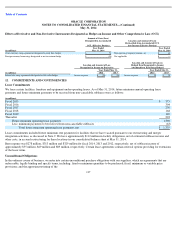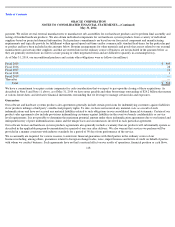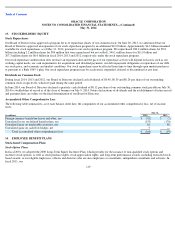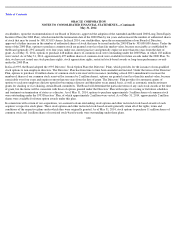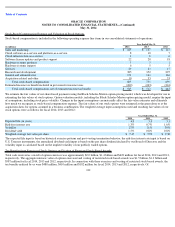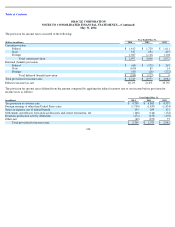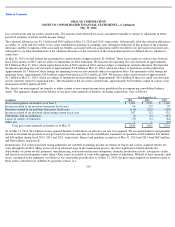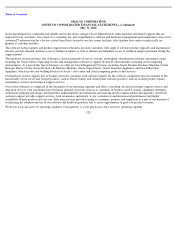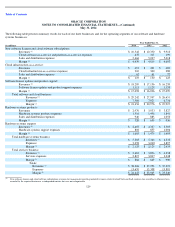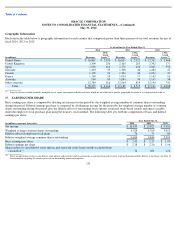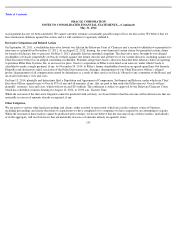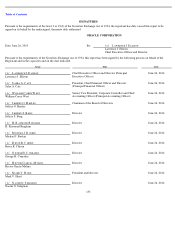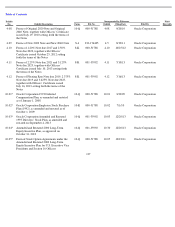Oracle 2013 Annual Report Download - page 131
Download and view the complete annual report
Please find page 131 of the 2013 Oracle annual report below. You can navigate through the pages in the report by either clicking on the pages listed below, or by using the keyword search tool below to find specific information within the annual report.
Table of Contents
ORACLE CORPORATION
NOTES TO CONSOLIDATED FINANCIAL STATEMENTS—(Continued)
May 31, 2014
combination of both) in the next 12 months by as much as $460 million ($364 million net of offsetting tax benefits). Our U.S. federal and, with
some exceptions, our state income tax returns have been examined for all years prior to fiscal 2003 and we are no longer subject to audit for
those periods.
Internationally, tax authorities for numerous non-U.S. jurisdictions are also examining returns affecting our unrecognized tax benefits. We
believe it was reasonably possible that, as of May 31, 2014, the gross unrecognized tax benefits, could decrease (whether by payment, release, or
a combination of both) by as much as $190 million ($142 million net of offsetting tax benefits) in the next 12 months, related primarily to
transfer pricing. Other issues are related to years with expiring statutes of limitation. With some exceptions, we are generally no longer subject to
tax examinations in non-U.S. jurisdictions for years prior to fiscal 1997.
We believe that we have adequately provided for any reasonably foreseeable outcomes related to our tax audits and that any settlement will not
have a material adverse effect on our consolidated financial position or results of operations. However, there can be no assurances as to the
possible outcomes.
We previously negotiated three successive unilateral Advance Pricing Agreements with the IRS that cover many of our intercompany transfer
pricing issues and preclude the IRS from making a transfer pricing adjustment within the scope of these agreements. These agreements were
effective for fiscal years through May 31, 2006. We have reached final agreement with the IRS for renewal of this Advance Pricing Agreement
for the years ending May 31, 2007 through May 31, 2013. However, these agreements do not cover substantial elements of our transfer pricing
and do not bind tax authorities outside the United States. We have finalized bilateral Advance Pricing Agreements, which are effective for the
years ending May 31, 2004 through May 31, 2006 and May 31, 2007 through May 31, 2013.
ASC 280, Segment Reporting , establishes standards for reporting information about operating segments. Operating segments are defined as
components of an enterprise about which separate financial information is available that is evaluated regularly by the chief operating decision
maker, or decision making group, in deciding how to allocate resources and in assessing performance. Our chief operating decision maker is our
Chief Executive Officer. We are organized geographically and by line of business. While our Chief Executive Officer evaluates results in a
number of different ways, the line of business management structure is the primary basis for which the allocation of resources and financial
results are assessed.
During the fourth quarter of fiscal 2014, we added a reportable segment, cloud infrastructure-as-a-service, as a result of the reorganization of
financial information presented to our chief operating decision maker for operational decision and resource allocation purposes. As a result, we
reclassified certain revenues and expenses for all periods presented within this note to conform to the current presentation.
We have three businesses—software and cloud, hardware systems and services—which are further divided into certain operating segments. Our
software and cloud business is comprised of three operating segments: (1) new software licenses and cloud software subscriptions, which
includes our cloud SaaS and PaaS offerings, (2) cloud infrastructure-as-a-service and (3) software license updates and product support. Our
hardware systems business is comprised of two operating segments: (1) hardware systems products and (2) hardware systems support. All other
operating segments are combined under our services business.
The new software licenses and cloud software subscriptions line of business is engaged in the licensing of our database and middleware
software, as well as our application software, and providing access to a broad range of our software through Oracle Cloud SaaS and PaaS
offerings on a subscription basis via a cloud-based IT environment that we manage, host and support.
The cloud infrastructure-as-a-service line of business provides deployment and management offerings for our software and hardware and related
IT infrastructure including virtual machine instances that are subscription-
127
16. SEGMENT INFORMATION


